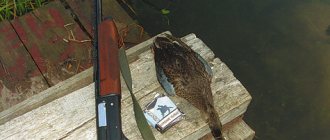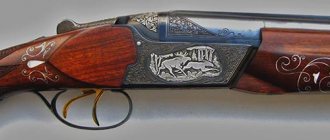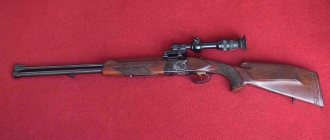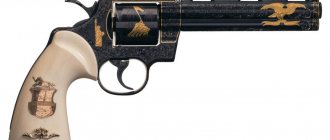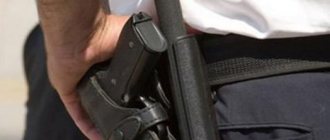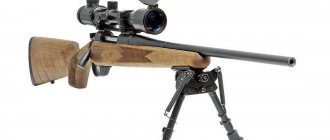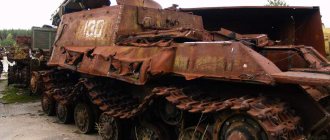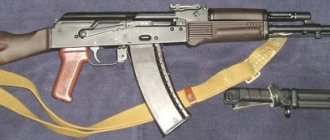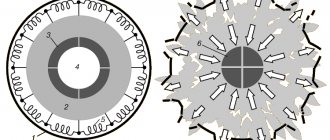Hunting weapons are divided into two types: smooth-bore weapons and rifled hunting weapons. Smoothbore weapons are mainly used for hunting birds and small animals. Rifled weapons, which have greater range and accuracy, are mainly used for hunting large animals such as wild boar, bear or elk. Some hunters want to have at their disposal weapons that combine the properties of both smooth-bore weapons and rifled weapons. Combined hunting weapons are produced for them.
A combined hunting weapon has both a smooth and a rifled barrel in its design.
Depending on the number of barrels, a combination gun can be of several types:
- Double-barreled , has two barrels in its design, one of them is rifled, the second is smooth. A rifled barrel is designed for firing a bullet at a long distance or at a large animal. The smooth barrel is designed for shooting, most often with shot, at birds at close range. A double-barreled combination weapon is often called a rifle. This is the most common type of combination shotgun.
- Three-barrel , has three barrels in its design, two of which are smooth and one rifled, or vice versa. Double-barreled combination shotguns are much less common. The heyday of the popularity of such guns occurred in the 20s of the last century, when in Germany and other German-speaking countries guns of this type became extremely common and in demand.
- Four-barrel , has 4 barrels, each of which can be either smooth or rifled. Four-barrel guns are extremely rare and exotic, intended more for gun collectors than hunters.
Advantages of combination shotguns
- Versatility is the main advantage of a combination hunting rifle; having it with you when hunting, you do not need to carry two guns with you and you always have a choice of which barrel to shoot from. A combination gun is especially convenient for single hunting, when it is possible to shoot game in a variety of conditions and from different distances.
Disadvantages of combination shotguns
- Combination guns, by the type of license required to purchase them, are classified as rifled weapons. In order to obtain a license for a rifled weapon, you must have at least 5 years of experience in owning a smoothbore weapon, so a young hunter will not be able to buy a combination gun as his first gun.
- Each of the barrels of a combined gun: smooth and rifled, require its own sighting device; for a rifled barrel, an optical sight is most often used, and for a smooth barrel an open type sight is used. Two sights of different types do not fit well on one gun; most often, the optical sight for a rifled barrel is removed and carried by the hunter separately, and, if necessary, quickly placed in the place intended for it. In any case, using two sights on one gun makes the gun much more difficult to use.
Hunting Gun
Bullet hunting rifle with a flintlock made by master Paul Poser. Prague. 1720s. From the collection of the imperial rust - chambers of the Moscow Kremlin.
No one will embrace the immensity. This aphorism by Kozma Prutkov, I am sure, will reflect the mood of anyone who suddenly decides to take on the task of writing the world history of hunting weapons in all its diversity of events, characters and technical details. It is much easier to consider such a question in the context of the history of a single country, especially if it is supported by carefully preserved artifacts. Bohemia, Silesia and Moravia were under strong Austro-German influence for centuries. German practicality and pedantry, coupled with the Slavic ability to take a creative approach to any task, gave excellent results in various spheres of human activity, including the production of hunting weapons.
The first hunting tools of primitive man were a stone and a stick, and hunting itself was the most important source of existence. Passive hunting methods, with the invention of the spear and then the bow, gave way to active and more effective methods. The “Neolithic Revolution,” associated with the advent of agriculture and cattle breeding, reduced the role of hunting in the life of primitive man. The improvement of hunting tools has practically stopped. And only in the early Middle Ages did weapons appear that were noticeably different from combat ones: a hunting spear and a hunting sword (it is also called a “boar sword”). As a result of the improvement of the bow, the crossbow arose. Its qualities such as speed and rate of fire exceeded those of the first types of hand-held firearms, which appeared in Europe in the 14th century and were absolutely unsuitable for use in hunting. The invention of the matchlock and hand weapons based on it in the 15th century added mobility, but not speed, so the crossbow was successfully used by hunters until the 17th century. When hunting primarily for feathered game, for just as long in the south of Europe, the “balestra” or “schneper” was used - a type of crossbow with a metal arc that fired round bullets.
Balestra of Italian type. Around 1600. Military Historical Museum. Prague.
Everything changed decisively with the invention of flint and wheel locks at the beginning of the 16th century; guns with these locks completely replaced crossbows in the 17th century. In Austria, Germany and the Czech Republic, the wheel lock lasted until the mid-18th century as part of the “high class” bullet hunting weapons for the rich. The rapid development of technology in the 19th century was accompanied by the emergence of new firearms systems. To be fair, it should be said that in addition to gun hunting, there were other types of hunting, for example, parfors, in which weapons were not used or served an auxiliary function.
A hunting spear with two built-in pistols with wheel locks and a hunting cleaver. Germany. Around 1540. Military Historical Museum. Prague.
I will start my story about Czech hunting weapons with Wilhelm Rosenberg (1535-1592). This surname comes from the name of the castle "Rosenberg", built in the 13th century by Vitek, who called himself Vok of Rosenberg and belonged to the ancient Vitkovic family.
Wilhelm Rosenberg
The Czech branch of the Rosenbergs died out in the 17th century. In the 16th century, representatives of the family settled in Courland. One of the descendants of this line of Rosenbergs, Andrei Grigorievich (Diedrich Arend), distinguished himself as a commander, Suvorov's comrade-in-arms and statesman. The other, Mikhail Fedorovich, was a Russian and Soviet artillery designer. Another, Alfred Rosenberg, a graduate of the Moscow Higher Technical School, ended his life as a war criminal on the gallows of the Nuremberg Tribunal. The ancestors of the Rosenbergs began the construction of Krumlov Castle in 1253, 170 km from Prague. In 1274, the city of Cesky Krumlov already existed around the castle, which became the center of cultural and political life in South Bohemia under Wilhelm Rosenberg. Currently, Krumlov Castle, the second largest in the Czech Republic, is included in the UNESCO World Heritage List. The castle museum houses a collection of weapons, including hunting weapons, which began in 1545. The first mention of a castle gunsmith dates back to 1572. His house was far from the smallest among the castle buildings. This fact is easy to explain if we take into account that the gunsmiths, who appeared in the 15th century in Prague and the surrounding area, were united in a guild in the 16th century and represented a strong class. They had no problems with orders, enjoyed the patronage of the rulers and gradually became richer.
Collection of weapons. Krumlov Castle. Czech Republic.
L. Kothera (Lumír KOTHERA, Myslivecké zábavy, 3/2009) provides interesting facts. Gunsmiths Benes and Bartos sat on the city council, their colleague Kubik owned two houses, a certain Vaclav bought land in the Old Town, and Martin invested, as they would say today, in vineyards. Surprisingly, all this coincides with the process of class differentiation that took place a century later in the Tula blacksmith settlement, as a result of which personalities of the caliber of Nikita Demidov appeared. The policy of the Habsburgs, represented by Archduke Ferdinand of Austria, who became king of the Czech Republic in 1526, led to the ousting of the Czechs and their replacement by alien German craftsmen. Of the 19 members of the Prague Armorers' Guild in 1592, only two had Czech surnames. The next Habsburg, Rudolf II, having ascended the throne in 1576, introduced a ban on hunting and carrying weapons on royal, read, state, lands, which, however, was regularly violated by his dignitaries. Throughout his life, Rudolf II was overcome by three passions: art in all its manifestations, occult sciences, to which he included astronomy, and hunting. The best gunsmiths of his time worked at his court in Prague. In the second half of the 16th century, a unique center of gun production was formed in the city of Teshin. Teshin craftsmen until the 18th century produced “teshinki” - light guns with an original wheel lock. The Germans called them Tschinke.
"Teshinka." 1640-1650. Collection of the Gatchina Arsenal.
The Peace of Westphalia in 1648 put an end to the thirty years of war that had devastated Europe and completely redrawn its map. For the Czech Republic, this war ended in 1625. It brought nothing but innumerable disasters, and the Habsburgs remained to rule the Czech Republic for another 300 years. However, from the point of view of organizing the hunting industry, this was not bad at all. And if Ferdinand III, unlike his father, a passionate hunter, Ferdinand II, was more interested in music than hunting, then Leopold I continued the reforms. In 1675, he issued new rules establishing the exclusive right to hunt and the wearing of special clothing by hunters. The rules contained measures to combat poaching and prohibited unauthorized persons from appearing in hunting grounds with weapons. These rules were amended and supplemented by Leopold himself, then by Emperor Charles VI, as well as by the Archduchess of Austria and Queen Maria Theresa of Bohemia. In the 17th century, famous European masters worked in the Czech Republic: Hans Mendel - the court gunsmith of Ferdinand III, Hans Stifter, Kaspar Neureuther, Adam Brandt, Marek Link, Kaspar and Georg Keyser, Hans Heiner, Georg Peter.
Bullet gun with a wheel lock made by Hans Gainer. 1660-1670 Collection of the Gatchina Arsenal.
Single-barreled breech-loading shotgun with a folding barrel and interchangeable chambers made by master Kaspar Neureiter. 17th century Military Historical Museum. Prague.
A gun of the same system made by master Leopold Becher. Carlsbad (Karlovy Vary). 1740s. From the collection of the imperial rust - chambers of the Moscow Kremlin.
In the second half of the 17th century, in addition to hunting for all kinds of ungulates, which was the lot of aristocrats, hunting for fur-bearing animals and game birds gained great development. The favorite subject of such hunting was the wild duck. To hunt it, special large-caliber “duck” smooth-bore guns with a long barrel were made, which could be secured to the boat by inserting a special spike on the fore-end into the side hole.
“Duck” gun by master Kaspar Neureiter. 1652 Military Historical Museum. Prague.
Fragments of two guns: with a flintlock and a wheel lock made by master Paul Poser. Prague. 1720s. Collection of the Gatchina Arsenal.
At the beginning of the 18th century, Czech gunsmiths flourished. In Prague, more than a dozen gunsmiths were engaged in the manufacture of hunting weapons. For comparison, there were 14 of them in Vienna, and 20 in Karlovy Vary. The fame of Czech (Bohemian) weapons also reached Russia. Major nobles of that time: Biron, Linar and Brümmer did not hesitate to acquire it for their collections, which later became the basis of the corresponding collections of our museums. Parforce hunting, as you know, appeared at the court of King Louis XIV of France. The Czechs consider the progenitor of this type of hunting in their country to be Count Frantisek Antonin Špork (1662 - 1738), the son of a peasant who became rich during the Thirty Years' War. An educated man and a passionate lover of hunting, he established the Order of St. Hubert, the patron saint of hunters, giving himself the title of Grand Master and Compiler. Sporck had excellent gunsmiths who made his name famous with the Sporck system, a revolver design in which four chambers were located on a common axis, and each of them had its own shelf and flint. The shooter, turning the chambers, stopped them one by one on the axis of the barrel, which made it possible to fire four shots without reloading. By the way, revolving systems appeared almost simultaneously with the first matchlock.
Repeating revolving shotgun with the “Sporck system” by master Johann Getischweiler from Karlovy Vary. 1740. Military Historical Museum. Prague.
The principle of multiple charges, implemented in successful designs of the 19th century, haunted gunsmiths long before the advent of the cartridge. In the second half of the 17th century, store structures appeared. Their detailed analysis is a topic for a separate discussion, but I think it’s worth mentioning these ancestors of modern repeating rifles. One of these designs, which had two tubular magazines in the buttstock, is known as the "Lorenzoni system". The first magazine was filled with bullets, the other with gunpowder. Behind the barrel there was a drum with two recesses. When loading, the gun fell with the barrel down. The shooter turned the drum handle, and the recesses were filled with bullets and gunpowder. At the same time, the hammer and flint were cocked. When the handle was turned in the other direction, the bullet, under its own weight, fell into the barrel, and the depression with gunpowder became behind the bullet. After the shot, everything repeated itself. Despite all the apparent complexity, the system nevertheless operated flawlessly. Well-known Russian specialist Yu.V. Shokarev believes that Michele Lorenzoni repeated the mechanism invented by the brothers Sigmund and Johann Klett from Salzburg.
Lorenzoni system. The lock is cocked (left). The lock has worked (the seed holes are clearly visible). The magazine cover is open (bottom left). Scheme of the mechanism.
There was a design where gunpowder was supplied from a powder flask, and only bullets were in the magazine. A number of other designs with different locations and magazine capacities are known.
Shotguns with the Lorenzoni system from the collection of the Military Historical Museum. Prague.
The reign of Queen Maria Theresa (1740 - 1780), an outstanding personality and exemplary mother who gave birth to 16 children, was marked by both the rise of the hunting arms business and, subsequently, its decline during the unsuccessful Seven Years' War (1756 -1763). Having received a male upbringing as a child, Maria Theresa loved hunting. Maria Theresa's son, Emperor Joseph II, who ruled independently from 1780 to 1790 and was allowed by his mother to govern the state during her lifetime, unlike her, was not an avid hunter and was indifferent to hunting weapons. He was more concerned about supplying the army. During his reign, weapons manufactories were created in Duchcovo, Spalena Poriči, Olomovets, Brno, Rimarov and other cities of the country, although the first weapons manufactories, including private ones, appeared during the Thirty Years' War. Imperial hunts formed an important part of diplomatic protocol. Joseph II was an ally of the Russian Empire and a personal friend of Catherine II. During the Russian-Turkish War, the emperor began military operations on the side of Russia, became seriously ill during the campaign and was forced to return to Vienna. There he met death with dignity, remaining in the memory of the people as a great reformer. The reforms of Joseph II also affected the hunting industry, which he considered as a source of replenishing treasury revenues. In the 18th century, hunting became available, for example, to the bourgeoisie. Some researchers consider this fact as one of the reasons for the appearance of double-barreled shotguns. Indeed, the nobleman did not need a second shot - there was always a servant with a loaded gun next to him, and the lack of high-quality barrel material made the double-barreled gun too heavy. The rise in the production of hunting weapons in the second half of the 18th century, which coincided with the beginning of the industrial revolution, gave way to decline during the Napoleonic wars of the early 19th century. At the same time, these wars were a powerful incentive to improve military firearms. There is no point in listing all the inventions in this area. They are well known. The epic Battle of Waterloo on June 18, 1815 marked the end of the era of Napoleon I Bonaparte and the beginning of a new round of the industrial revolution.
Single-barrel capsule shotgun according to the patent of A.V. Quinoas (above). 1829 Double-barreled shotgun by master F. Novak. 1840 Military Historical Museum. Prague.
The unique situation with the production of hunting weapons in the Czech Republic in the 19th century was the presence of a large number of excellent craftsmen throughout the country: Ferdinand Moravek, Josef Rutte, Antonin Legler, Hynek Wangler, Vaclav Müller, Jan Gaberda, Antonin Kehlner, Vaclav Sekera, Jan Olischer, Frantisek Novak, Vashirovsky, Mashek, Prochazka, Dubina from Mlada Boleslav, whose percussion gun is in the Hermitage collection, and many others. The most famous among them was Antonin Vincent Lebeda (1797-1857). Lebeda's workshop produced weapons of the highest quality at an affordable price, earning the love and respect of hunters throughout Europe, but especially in Russia and Poland. In 1828, he was the first of the Czech gunsmiths to receive a patent for his own design of a receiver with a lock, called the “Prague” (“Prager Kastenschlosses”). This design was used by many gunsmiths, including English ones. Famous artists Josef Menes, Josef Navratil and Vaclav Sekal participated in the creation of the decoration of the Lebeda guns. The master’s sons, Antonin and Ferdinand, although they were skilled in the production of guns of the Lefoshe system, “lefoshek”, as they are called in the Czech Republic, did not have their father’s talents, and in 1888 Lebeda’s company ceased to exist.
Double-barreled percussion gun by master Antonin Legler. 1860 Military Historical Museum. Prague.
In 1825, the Belgian entrepreneur Louis Sellier and the French chemist Nicolas Bellot received the privilege of Emperor Franz I to produce capsules, laying the foundation for the oldest company in the Czech Republic and Europe, Sellier & Bellot. In 1837, the company produced 156 million (!) capsules per year. In 1884, a plant was built in Riga, covering the needs of Russia and the Scandinavian countries...
Lefoshe system shotgun (above). 1870 A Lancaster system gun made by Jan Gaberda, the gunsmith of Prince Adolf Schwarzenberg. 1880 Military Historical Museum. Prague.
Yes, the Czechs have something to be proud of. Over the course of 4 centuries, their craftsmen went from a flintlock to an internal breech-loading system, creating samples, some of which, without exaggeration, can be considered masterpieces of weapons art. Czech hunting weapons up to and including the 19th century are of significant interest to collectors and researchers, which, unfortunately, cannot be said about weapons of a later period.
Share this:
Liked this:
Like
